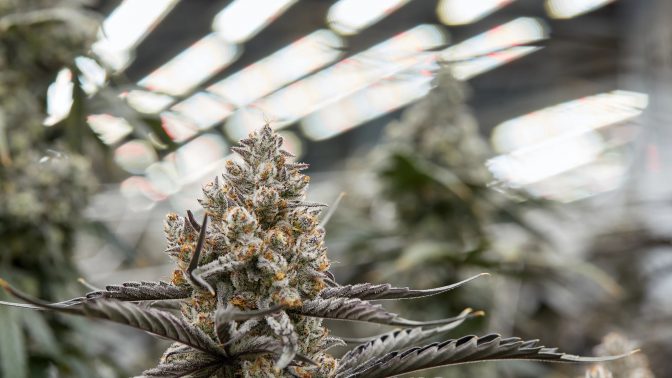The primary benefits of building a covered structure for your plants is protection from wind and rain. The clear plastic covering will also diffuse the sun into a light that is typically absorbed better to produce happy and vigorous plants. However, the number one reason for building a hoop house structure is so that you can deprive your plants of light. Light deprivation is a common practice for outdoor cannabis growers in Northern California and Southern Oregon because it allows growers to harvest two times in the summer season by manually controlling the light exposure (similar to indoor growing).

A hoop house structure will allow you to easily black-out your plants with a large tarp, controlling the number of hours of light your plants receive per day. So in June when the days are 15 hours long, you can manually shorten them to 12 which will prompt your plants to begin their flowering stage. Beginning a light dep in June allows for a harvest in August - two months before outdoor growers are traditionally harvesting (end of October).
First, scout for the perfection location to place your greenhouse. You're looking for a plot that has relatively smooth and level ground with good high sun exposure. Pro-tip: Orienting the greenhouse east-west will ensure maximum sun exposure.
Now it's time to get started building.
Materials:
- Wood planks (at least 6-12in in width)
- 1in PVC piping - 10-foot length increments (Schedule 40)
- 4-way Cross PVC slips
- PVC Cutters (heavy duty)
- PVC Primer & PVC Glue (dual pack sold online)
- PVC Plastic Clips (Snap Clamps)
- Metal brackets (as shown in photo below)
- Screws
- Drill
- Clear Plastic Covering
- Black-out Tarp
*The quantity of PVC piping, 4-way slips, and metal brackets will depend on how large you plan on building this hoop house. I recommend not exceeding a 5-foot width so you can still reach the interiors of your plants without compromising the stability of the structure. The length, however, is up to you!
Procedure:
- Blueprint where you are going to place your greenhouse. Before building the structure, dig two trenches (approx. 3'x3'x3') on either end so that half of each hole is inside the structure and half is outside. This is the most labor-intensive step of the day, but it will ensure proper airflow and prevent mold caused by humidity issues. I recommend placing one can fan in each trench but a less expensive route would be to use basic box fans. These underground fans prevent stagnant air in the hoop-house at night when it is covered completely with a tarp.

- Begin by framing out the base of the greenhouse. It's best to use untreated wood between 6-12” wide; this specific size is recommended so that when you fasten your PVC with metal brackets there's more tension to hold your hoops in place. How much wood you will use depends on the size of the greenhouse you're building. For this style of hoop-house I recommend limiting the width of your greenhouse to 5 feet for ease of access to plants and pulling the light dep tarp - but the length can vary to whatever your plot allows.
- *optional step: You can fill in the base of the greenhouse with gravel if you desire. If you're planning on using this greenhouse throughout the winter and you live in a soggy region, the gravel is recommended.
- Figure out how many ribs you are going to have down your structure. I recommend spacing the ribs about 1 ½ to 2 feet apart. Once you have the number, cut your 10-foot length PVC pipes in half so that you have pieces that are 5-feet long.
- Using screws, a drill, and the metal brackets, secure the 5-foot long PVC stakes upright along the length of the greenhouse base to whatever spacing you need (1 ½ - 2 ft). Make sure the PVC on either side of the base matches up evenly.
- Attach the 4-way PVC slips to the tops of the 5-foot PVC stakes sticking out of the base (which should now be attached with the metal brackets). It's best to use the PVC primer and PVC glue for this step to ensure this structure will withstand the test of time. *The 4-way PVC slips allow for the addition of a trellis net which your plants will greatly appreciate and reward you back with a larger harvest.

- Now it's time to bend the ribs across the structure to create the hoop-house ceiling. Attach one end of 10 foot PVC pipe to the top opening of the 4-way slip using PVC primer and PVC glue. Bend it down gently and place it into the 4-way slip directly across the base, creating a large arch with the 10-foot piece of PVC. Continue this process all the way down the length of your hoop-house until all the stakes are connected with ribs.
- This next step is for the stability of the structure and to provide additional support to your plants. Cut down some more PVC into 2-foot pieces (or however far apart the ribs of your hoop house are). Use these smaller pieces to connect the ribs horizontally, fitting them into the vacant 4-way slip openings to create a rail along the length of the structure. Once your plants grow to this 5-foot mark, you can add a plastic trellis net to weave your plant through and support all of the extra weight during flower.
- The final step is attaching the plastic to the top of your structure. PVC clips make it easy to simply snap on over the plastic to secure it in place. I recommend only placing plastic across the top of the hoop house so that the sides have open airflow. (You can cover the entire structure with plastic if you want to but you will need some serious fan action inside to prevent mold or mildew caused by too much humidity).

Now that your structure is complete, fill it with plants and watch them thrive in their new environment! To take advantage of the light depping ability all you have to do is be on tarp patrol. Set an alarm for 10 minutes before 7 a.m. and 7 p.m. (or whichever 12-hour increment works for you) so that you can remove and replace the black-out tarp at the precise time. If you begin this in June or July, you can beat the natural growing season and harvest earlier than everyone else growing straight outdoor.
Pro tip: White PVC can be spotted from a mile away and sticks out like a sore thumb. If you want to be more discreet, you can use green and brown spray paint to camouflage your hoop-house.
So there you have it! With a minimal investment and a couple of hours of time, you have your very own greenhouse that protects your plants from the elements and allows you to harvest twice during the summer season!




